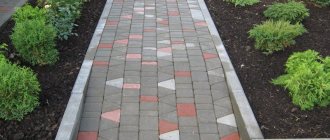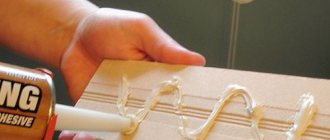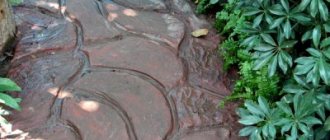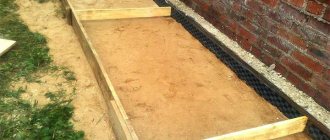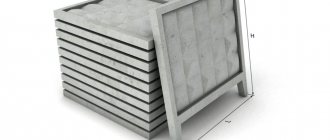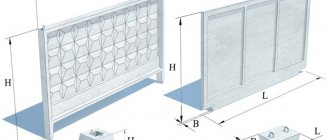- Fencing for beds: functionality
- The main types of borders for beds and flower beds
- Plastic border for garden beds
- Buy fencing for beds in the form of a tape - a cost-effective solution
- Wrought iron garden fences
- Wooden structures
- Wooden fence made of pegs or stumps
- Brick border
- Fences for beds and flower beds made of natural stone
- Fencing made from alternative materials
- Video: Fencing for flower beds. DIY ideas for your cottage and garden
Fencing for beds : borders for beds and flower beds. An interesting trend in recent years has been the use of various fences for beds and flower beds in garden plots. Neat borders protect garden paths from soil contamination and serve as a picturesque element of landscape decor. They are made from wood, natural stone, brick or plastic. Plastic dishes, bottles, tires, tin cans and household utensils are used as alternative materials.
Framing the garden
What is “garden framing?” On an aesthetic level, framing is about defining the visual boundaries of your property. For example, between a lawn and a garden, a flower bed and a decorated mulched area, etc. Garden edging is also known as lawn edging or landscape edging. The most common type of edging is a simple garden border. Borders in the garden are usually used to fence and protect the edge of the bed from destruction and are an integral part of the garden landscape. Accordingly, they should be planned with great attention.
To begin with, it is necessary to model the shape of the future fence and only then begin to select the appropriate material. Decide how much money you are willing to spend on a new “pleasure” and get to work. Before installing a garden border, you should take into account that the material from which the border will be made must fit perfectly with the plants in the garden and be functional. It is important that the border is beautiful and durable. Depending on your wishes, it can turn into an inconspicuous border between bright flowers and the lawn, or it can turn into one of the decorations of the garden.
Plastic borders
A simple solution for almost all vegetable gardens. Plastic fencing is available in different versions to suit any design. There are both discreet elements and bright, eye-catching sections.
There are the following types of plastic borders:
- Flexible tape - this fence is rolled into a roll, it is rolled out to the required length and given the required shape, such a fence can follow all the curves of the path. The tape is buried in the ground 23 times its width, so it is almost invisible on the site, but it copes with the tasks assigned to it.
Plastic borders can have any shape and design Source cdn.decoratorist.com
- Sectional borders for paths consist of a set of elements that are interconnected to form a decorative fence. Each section is attached to the other using special locks, which simplifies and speeds up installation.
- Imitations - plastic is made in the form of other materials: stone, tiles, wood, brick, etc. The fence can also be assembled in a matter of minutes.
Purpose, range
Plastic curbs are intended for landscaping parks, pedestrian areas, personal plots and areas near private houses.
They serve as a fence between lawns, flower beds, beds, sidewalk paths and paths of garden plots, and they also always provide an improved and beautiful appearance for your site! These products are made from heat-resistant polypropylene, which is almost not subject to corrosion and is resistant to mechanical damage, and plastic that is resistant to moisture and chemicals.
Standardpark offers a wide range of products for limiting zones of various types, shapes and colors depending on the purpose and place of application:
- For garden paths;
- For sidewalk paths;
- For lawns;
- For flower beds and flower beds.
To beautifully frame the territory of your site, use the “Kanta” border (improved in “Country”), the “Pebbles” decorative border or the “New Fix” sidewalk border. With the help of such a “frame” you can successfully transform and emphasize a variety of landscape compositions.
Advantages and disadvantages of using plastic
Artificial fences are good because:
- Available in different colors and can be of almost any shape and size;
- service life is several years;
- installation does not require special skills or knowledge, all work can be done independently;
- require minimal or no care at all;
- resistant to temperature changes, high humidity, chemicals, and other aggressive substances;
- The product is available in any price category, so choosing something that fits your wallet will not be difficult.
Plastic borders have few disadvantages. The main one is the artificial origin of the material. However, the fences are safe for humans and plants. Plastic is also less strong and durable than stone, brick, concrete or metal. Due to its instability to impacts, it is not recommended to use plastic when lining gravel paths.
No special skills are required to install the tape Source ru.all.biz
Concrete rings
The concrete rings remaining after construction are perfect for creating an original landscape on the site. They will serve as a reliable and durable fence for flower beds or perennial plantings.
Concrete structures will prevent the growth of unwanted vegetation on the site, and in case of excessive watering they will ensure moisture retention. In autumn and spring, the walls can be treated with special preparations against mold and fungi, which will provide additional protection to seedlings and prevent diseases of garden crops.
Concrete structures provide a long service life, and the variety of options for their use allows you to create unique structures at low cost. Such fencing guarantees visual appeal and practicality during operation.
AlinaAuthor of the article
Did you like the article?
Share with your friends:
Installation of plastic borders
Curbs of all types are installed according to a similar pattern:
- A line is drawn along the path along which the fence will go.
- The cord is stretched: it will allow you to monitor how evenly all the elements are located in height.
- A narrow ditch 8-10 cm deep is dug along the path.
- While the preparatory work on marking the area continues, you can warm the border in the sun: it will become softer and more pliable, and if it is a tape, it will be easier to cut it to size.
- The fence is carefully inserted into the groove and fixed using the anchors included in the kit, checking the evenness of the installation along the cord.
- If a sectional border is used, then all elements must be fastened together with a locking connection.
- The earth is poured back into the groove and carefully compacted, making sure that the fence does not deviate from the vertical.
Plastic borders are well suited for earthen, sandy and sawdust-strewn paths, as they prevent grass from growing and help the path maintain its shape.
Concrete curb
This type of curbs is used to complete the design of asphalt paths paved with paving slabs, as well as concrete, stone and paving stones. This is a rigid and reliable fence that can last for decades.
Concrete sides are best combined with paths made of paving slabs Source 709703.ru
The main advantages and disadvantages of concrete curbs
Strengths of the curb:
- durability: can last half a century;
- strength, resistance to mechanical loads;
- easily tolerate temperature changes;
- undemanding to operating conditions and maintenance;
- look neat;
- resistance to water and chemicals;
- accessibility and prevalence: you can buy a concrete border for garden paths or make it yourself.
There are also negative qualities:
- heavy weight;
- thorough preparation of the land and skills in working with cement, stone, and tools are required;
- rustic appearance, limited selection of designs for ready-made products.
Advantages of fencing for garden beds
A garden bed border will create nice, neat spaces for growing vegetables and berries. It will fit perfectly into any landscape design and will give the garden an orderly and strict appearance, while maintaining the aesthetics of the plantings.
In addition to their aesthetic function, such fences will help reduce water consumption during irrigation, since all the moisture remains in the right place and does not roll off to the ground.
How to make a concrete side on your site
There are 2 options for making a fence on your site. You can assemble it from ready-made blocks, make them yourself, or fill the border directly on site.
Working with blocks
The finished parts of the border have standard dimensions. Lay them edgewise or wide side.
The concrete block is very heavy, so thorough preparation of the ground is required. Lay it like this:
- Dig a trench a little wider than a block and about 20 cm deep.
- A layer of crushed stone is poured and compacted.
- Sand is poured on top, watered and compacted. It needs to fill all the cracks.
- Concrete is poured onto the prepared “cushion”, and blocks are immersed in it.
- The border is leveled using a level or a stretched rope, tapping with a rubber hammer.
- The remaining mortar is used to seal the joints.
The fence can be installed simultaneously with the creation of the path or after it is ready.
Self-production
If standard blocks are not the right size, you can make them yourself. To do this, you will need molds: you can buy ready-made plastic ones or assemble them yourself from wood or channel. If you need a colored curb, then add the desired color to the solution when mixing. The dosage depends on how intense the tone is required. You only need to buy paint suitable for such work. After the solution has hardened, the finished products are removed from the molds and installed in the same way as purchased ones.
A multi-colored border enlivens the area and brings fresh notes Source sandstone.by
Another option is to pour concrete fencing into the formwork. A strip foundation is made in a similar way:
- Dig a trench where the formwork will be installed.
- The formwork is made of boards, plastic or steel and secured with pegs.
- Cement mortar is poured into the finished form and compacted to remove all air bubbles. Then the concrete will be strong.
- Then the surface is leveled.
- After the concrete has hardened, the formwork is removed and expansion joints are cut every 1-1.5 m.
- The final stage is filling with earth and compacting it.
A border filled using this method is not aesthetically pleasing and will require additional decoration. But it will be durable and reliable.
Modern methods of creating fences
The fences that gardeners really like to resort to these days are called pergons. They are made from mesh, which can be found in any market. As a last resort, you can weld the rods yourself.
The mesh is used to form a fence simply and quickly. Moreover, and importantly, this method will not harm your finances at all. In addition, to form the fence, you can use materials that were left unnecessary after the construction of the greenhouse.
If your garden is large enough, you can use the same mesh to create a real hedge on the site, which will serve as a visual divider of the territory or as an ordinary decoration.
Which method should you choose? Considering the number of ways to create fences there are, it is quite difficult to make a choice. There are a huge number of factors to consider, without forgetting your own preferences. We can tell you only one thing for sure: if you are looking for the simplest, least expensive method in terms of money and time, which will still give a relatively beautiful result, use wooden boards. In your case this will be the best option
How to make a wooden fence?
As you probably guess, this process, no matter how simple it may seem, has a huge number of nuances that need to be taken into account. We will discuss them now.
Which material to choose?
Naturally, the first thing we do when building a wooden fence is choosing the right type of wood. However, given that there are a huge number of them, the choice no longer seems so obvious. In fact, among the types of wood there are obvious favorites. For example, oak or ash are best suited for creating a fence. Coniferous types of wood, such as pine, are also quite good. Its striking difference from oak or ash is its cost. Pine is much cheaper, so we recommend choosing it.
How much material will be needed
In order to calculate this, you will need to make many measurements. Everything is taken into account: the depth, length and width of the box. However, let’s say our box will have dimensions of 1x1.6 m. In this case, we will need 150x25 mm boards: four two-meter and two three-meter. In addition to the boards, we will also need a lot of screws and tools.
Metal border
Metal borders are among the most durable and strong. They are made of copper, aluminum or stainless steel and coated with a polymer coating that protects against corrosion. Metal products are produced in the form of ribbons or decorative grilles and rods. Their edges are often rounded.
Laying a metal border strip Source acodrain.com.ua
The ribbons are practically invisible on the site: they should protrude from the ground no more than 2 cm, and deepen by at least 10 cm. Therefore, the total height of the border should be at least 12 cm.
Decorative grilles are used if they want to decorate an area in a single style, for example, so that the decorative elements of a fence and border for a garden path have something in common. Each owner determines the height of the protrusion independently.
Advantages and disadvantages
Metal products are popular because:
- have high strength;
- serve for decades;
- tolerate temperature changes well and are resistant to strong heat;
- keep the shape of the tracks well;
- ideally isolate paths from grass growth;
- optimal for bulk paths, for example, made of crushed stone;
- easy to install;
- can be used for winding paths.
The only downsides that can be noted are the high price of the fences, as well as the fact that the metal can react with some chemicals.
Installation
Installing metal borders does not require special skills. The tape is simply immersed in the ground to the desired depth. You can tap it with a hammer or mallet. There is no need to dig trenches for the tape. Another option is to secure it with special pegs.
Natural stone in fencing beds
It is convenient to use natural flagstone instead of brick. In mountainous regions, fragments of this rock have to be cleared from garden soil. Flat parts are well suited for fencing and fencing. You can buy natural flagstone if you want to decorate your garden, the basement of your house, and your garden beds in the same style. Other available materials are cobblestones and large pebbles. It can be collected along the banks of rivers. It differs from flagstone in its rounded outline. It is more difficult to make masonry from it. Both types of materials should be cemented together so that the curbs can support the weight of the soil inside the high ridge. If the soil is not poured, then you can plant around the perimeter of the ridges without mortar, placing large beautiful stones in one row.
Wooden borders
You can use wood to create a variety of fencing options for garden paths. You can purchase ready-made ones or make them yourself. It is not necessary to buy new lumber for the work; leftovers may be suitable. For example, if you recently built a house, there are likely to be saw cuts from timber or rounded logs. These “bubbles,” if trimmed and processed, can be placed on the side along the path near the house. They will look original. You can also use boards, pegs or rods. Wooden borders are suitable for paths sprinkled with tree bark or sawdust.
The fence can be made from small pieces of timber Source www.santabarbaradesignhouseandgardens.com
Advantages and disadvantages
Advantages of wooden borders:
- aesthetics: even with minimal effort you can make a beautiful fence for a path out of wood;
- environmentally friendly material;
- high strength.
There are also disadvantages here. Thus, wood, even treated, is significantly inferior in durability to metal and concrete, usually within 10 years. Installation is not simple: it is necessary to provide drainage and waterproofing. Yes, and assembling the fence will take time. Not all types of wooden edges are equally good at preventing grass from growing, for example, wicker fences look beautiful, but cannot prevent it from appearing on the path. They won't be able to hold the embankment either. Therefore, they must be combined with plastic or metal tapes.
A combination of sides made of different materials allows you to zone the area Source usdecorating.com
Manufacturing and installation of wooden fences
To make a beautiful border, you can use any lumber: boards, bars, saw cuts, etc. The good thing about wood is that it can be easily processed, burned, and can be painted and varnished. There are many options for making decorative borders: from simply laying boards along a path to a carved picket fence. One of the simplest and most aesthetic solutions is fencing made from saw cuts. Work begins with preparing the elements:
- All parts of future sides are aligned by size: length, width, height. They must be cleaned of bark and dirt.
- Treated with impregnations that protect against rotting. The solution is applied to the boards with a brush. It is better to soak the saw cuts by immersing them in an antiseptic for at least 23 lengths.
- Dry well.
- Dig a trench and pour sand into it. It is necessary to have a drainage system and waterproofing for the material to last a long time.
- The parts are placed on a sand cushion and driven into it. To prevent the wood from cracking, use a mallet rather than a metal hammer.
- The upper part of the cuts is painted or varnished: this way the wood will look better and last longer. The coating imparts decorative qualities and protects against weathering and rotting.
Types of fencing for garden beds
Naturally, the first question that arises when building a fence is what to make it from? Everyone has their own taste and their favorite materials. Some people prefer wood, others prefer stone. Some people think that it’s much better to make a garden bed yourself, while others think that you simply can’t do anything better than a store-bought one. Therefore, what material you will use is an entirely personal decision for everyone.
Do not forget, however, that our instructions are not postulates, and when it comes to fencing for garden beds, with your imagination you can really go wild and come up with something that no one has ever made, like from wood, and from slate.
However, naturally, the same tree or stone border has both its pros and cons, which we will tell you about and help you make your choice.
Wooden fences
The good old tree: perhaps most gardeners prefer to resort to it. In addition to the fact that this material is available to absolutely every gardener, it is also distinguished by its endless variety and natural style, which many people like. For fencing, you can use both old, used boards and freshly purchased pieces of wood. By the way, their height is often more than enough to make a full-fledged bed from just one tier of wood.
However, of course, the availability of wood, although important, is not the only factor pushing people to use this particular material for their fences and barriers. In addition to the fact that wood will not harm your wallet, it also makes the beds much healthier: since wood is a “living” material, it perfectly allows both moisture and air to pass through, which is extremely important for any plant. And, of course, it is also important that the tree fits perfectly into the landscape of any site due to its proximity to nature.
However, everything has its drawbacks. This includes wooden fences: if you do not resort to special treatment, they are very susceptible to the destructive effects of moisture: when left in the ground for a long time, the wood simply rots. That’s why we need special preparations that impregnate it and prevent it from being destroyed by moisture. It is incredibly easy to carry out such procedures with wood, because it can easily be processed in any way. By the way, it is not at all recommended to resort to ordinary paint for these purposes, since it will crack sooner or later in any case.
Fences made of vines
I think everyone has at least once seen a fence made of vines on someone’s property. Naturally, you immediately want to install the same one for yourself. Indeed, it looks beautiful, it seems easy to make: why not? And yes, it’s really simple to make: ordinary weaving principles are applied here: pegs are driven in at equal distances from each other, around which elastic willow is braided. Moreover, the longer you want the fence, the smaller the distance between the pegs should be. This way the vine can be given any shape. However, with fences made from it, everything is not so simple. The fact is that such a fence is not very suitable for the role of a full-fledged barrier. Most often it is used exclusively as a decorative addition to a wooden or stone barrier.
Question about plastic bottles
Surely everyone saw the plastic bottles used as barriers. At every entrance of any high-rise building there will definitely be a small garden studded with countless plastic containers. And this is really quite an economical, convenient and simple way to create a fence. However, unlike the others on this list, a bottle barrier is the least aesthetically pleasing of all the gardening options available. They look foreign and simply unnatural. So, if you are not least concerned about the beauty of your site, it is better to send the bottles for recycling, and put the fencing on wood, brick or other material.
Durable fences
Even if a tree or vine looks beautiful, nothing can make it remain in perfect condition for several decades. Unlike stone. He, in turn, is not afraid of cold, heat, moisture, or sun. That is why it is on him that the gaze of gardeners and gardeners often falls.
Concrete fencing
Many people prefer reliability to beauty. However, concrete is a material that can easily combine both of these qualities. Fences made from such a seemingly simple material can last for decades. In addition, concrete does not require the skills of a professional builder: you just need two hands, and the work will already begin. However, concrete still has some features. Therefore, when using it, you need to thoroughly prepare by digging a deep trench around the area that you want to fence. After this, a 10-centimeter layer of crushed stone is poured into the pit itself. Without a trench filled with drainage, you don’t even have to start preparing concrete. If everything is ready, you can make fences either from individual concrete blocks or resort to creating a monolithic wall. In addition, they can be easily transformed into something beautiful by applying some kind of pattern.
Metal fencing
There are also gardeners who like to modernize everything. For them there are beautiful, smooth, sparkling metal fences. For their manufacture, completely different metals are used, for example, steel or stainless steel. Such materials are extremely durable and are almost not subject to corrosion, which simply cannot be avoided in the conditions of a garden and high humidity all around. However, metal fences have one significant disadvantage: they heat up terribly in the sun, which can lead to drying out of the soil and the need for constant additional watering. And if the soil dries out too much, damage to the plant root system cannot be avoided.
In addition, it is very important to know what kind of metal you are buying. Because, for example, galvanized steel cannot be coated with anti-corrosion agents or painted.
Fences made of decorative stone
Decorative stone is also one of the favorite materials used by many gardeners and gardeners who want to improve and decorate their site. Artificial decorative stone may not be the cheapest material, but it is definitely cheaper than natural stone. In addition, many gardeners note its exceptional strength and practicality. Often, high flower beds and beds are made from decorative stone. However, in order to not only lay a stone beautifully, but also correctly, you need at least minimal masonry skills and a sense of style. However, if you have them, you can easily get not only practical, but also beautiful fencing.
By the way, when making a stone border, it is worth remembering that it should not be an airtight “cage” for your plants. Therefore, in the lower tiers it is simply necessary to make special holes through which moisture can escape. Otherwise, it may stagnate and damage the roots.
Brick fencing
Brick still remains the real leader in strength, decorativeness and reliability. This material is a real find for gardeners and gardeners. Any brick fence looks solid and immovable. Therefore, it perfectly protects the garden bed from all kinds of weeds and even moles. There is no need to talk about shrew mice. Even though laying bricks is not an easy task, the result is worth it. For particularly high barriers, you may even have to make a foundation. However, if the bricks are heavy enough and the fence is not going to be very high, you can even do without masonry.
However, despite all the advantages of brick, it has a major drawback, especially if we are talking about its decorative variety: it is very expensive. And considering the quantities in which it will have to be used, not every gardener will be able to afford such beauty. In any case, you can always use old brick.
Slate fencing
As many years of practice have shown, slate is an incredibly versatile material. Why isn't it used for? And fencing for garden beds is not the least of its possible uses. Even very long beds can be made from slate sheets, but for this you will need strong pegs that can provide additional support to the slate sheets. Moreover, you can use both smooth and wavy slate to create fences. Its problem, however, is the same as with metal fences: under direct sunlight, the slate overheats excessively, which can either benefit the site in the cold season or harm it in the already hot summer. In addition, it is necessary to take care of a good fastening for the slate, because by itself it does not stay in the ground very well.
Use of car tires
Along with plastic bottles, gardeners love to use old tires for decoration and as fencing. However, tires are much better suited for this purpose: they can be used as flower beds and even huge beds, if we are talking about tractor tires. However, to arrange your tires beautifully on your property, you'll need some pretty good design sense. You've probably seen more than once how tires are painted in all sorts of eye-catching colors just so that they don't blend in with the ground. However, this is fundamentally wrong, and it is better to take the advice of a person who understands landscape design in order not only to use old tires as a convenient flower bed, but also to make them a real decoration of your site.
Using household items to create fences
In order to make a beautiful and practical fence for your site, you don’t have to immediately run to the “Garden and Vegetable Garden” store. Comb through your stocks of unnecessary, old things, and I’m sure you’ll easily find something for your site. For example, you can use:
1) Old wooden doors. In order to use them as garden bed fences, you will need to pre-dig a deep trench that can accommodate at least half of the door. This will provide it with an incredibly strong fastening, and you will have a comfortable, high flower bed. In addition, this door structure can be used to infuse compost.
2) All kinds of boxes and containers. They are most often not very large, so they are best used as flower beds and flower beds.
3) Even from old, useless dishes, you can make a beautiful decorative fence for a flower bed or garden bed. However, it obviously will not fulfill its main task: to protect plantings from weeds and pests.
Borders made from scrap materials
Fences for paths can be made from scrap materials: plastic or glass bottles, car tires, vines, stones left over from the construction of bricks, slate or tiles, etc.
Bottle fences
Drink containers are one of the most accessible types of recyclable materials. They are quite resistant to water and chemicals, only impacts pose a serious danger to them. You can make a border for a garden path from glass or plastic bottles. The first option will be more durable.
Sand, small pebbles or crushed stone are poured into the bottles up to half. The neck is clogged. A cord is placed along the path. The height of the curb will be aligned with it, and the twine will also prevent you from deviating from the straight line. Dig a trench to the depth of half the bottle and fill it with cement mortar. The container is inserted neck down and aligned with the cord. Bottles can be placed straight or at a slight angle. Then the concrete is covered with earth. If desired, the resulting fence can be further decorated.
Bottles can make an original fence Source kakpostroit.su
Plastic bottles can be installed in a similar way. They can also be used as temporary fencing. Then the side is made according to a simpler scheme: they cut off the neck of the bottles and insert them into the ground. The soil must be compacted well so that the container holds. The top of the plastic can be painted. Or arrange bottles, alternating them by color.
Plastic bottles have long become a popular building material Source lookathis.ru
Car tires
A curb from old rubber can be made in different ways:
- I bury the old wheels halfway into the ground. The soil around is well compacted. The tires are then painted.
- Strips of suitable width are cut from rubber and secured to bars dug into the ground. Sometimes such tapes are placed on cement mortar so that they stick better.
Tires have long been used to decorate garden plots Source i.mycdn.me
Brick remains
The brick left over from construction is an excellent material for fencing paths. It is strong, durable, environmentally friendly. In this case, the bricks can be placed in any way: vertically, horizontally, at an angle. You can simply dig it into the ground, but it’s safer to “plant” it on cement mortar. In this case, the technology resembles working with bottles: they dig a small trench, fill it with concrete and lay bricks. To make the side even in height, you need to tighten the cord.
Brick as a fence looks very aesthetically pleasing Source remboo.ru
Materials for fencing beds
The materials most often used are wooden boards, plastic panels, iron strips, bricks, and stones.
Sometimes slate, plastic bottles, and old car tires are used as fencing. But the latter types of fences must be approached very carefully.
All of them can release harmful substances that are easily absorbed into grown vegetables. Therefore, it is better to use such elements when creating flower beds and flower beds.

